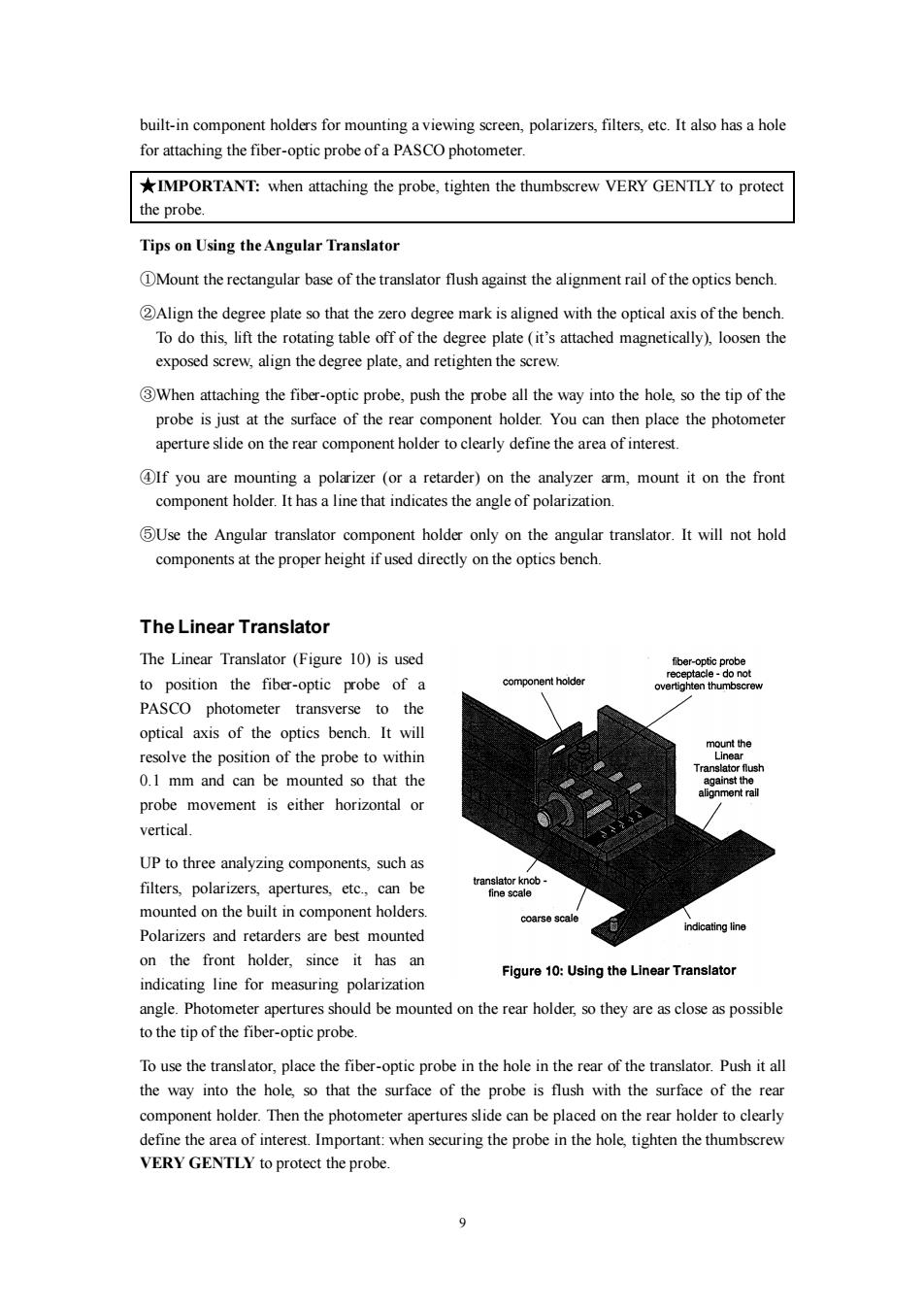正在加载图片...

built-in component holders for mounting a viewing screen,polarizers,filters,etc.It also has a hole for attaching the fiber-optic probe of a PASCO photometer. *IMPORTANT:when attaching the probe,tighten the thumbscrew VERY GENTLY to protect the probe. Tips on Using the Angular Translator DMount the rectangular base of the translator flush against the alignment rail of the optics bench. Align the degree plate so that the zero degree mark is aligned with the optical axis of the bench. To do this,lift the rotating table off of the degree plate(it's attached magnetically),loosen the exposed screw,align the degree plate,and retighten the screw. 3When attaching the fiber-optic probe,push the probe all the way into the hole,so the tip of the probe is just at the surface of the rear component holder.You can then place the photometer aperture slide on the rear component holder to clearly define the area of interest OIf you are mounting a polarizer (or a retarder)on the analyzer arm,mount it on the front component holder.It has a line that indicates the angle of polarization. 5Use the Angular translator component holder only on the angular translator.It will not hold components at the proper height if used directly on the optics bench. The Linear Translator The Linear Translator (Figure 10)is used fiber-optic probe receptacle -do not to position the fiber-optic probe of a component holder overtighten thumbscrew PASCO photometer transverse to the optical axis of the optics bench.It will mount the resolve the position of the probe to within Linear Translator flush 0.1 mm and can be mounted so that the against the alignment rall probe movement is either horizontal or vertical. UP to three analyzing components,such as filters,polarizers,apertures,etc.,can be fine scale mounted on the built in component holders. coarse scale Polarizers and retarders are best mounted indicating line on the front holder,since it has an Figure 10:Using the Linear Translator indicating line for measuring polarization angle.Photometer apertures should be mounted on the rear holder,so they are as close as possible to the tip of the fiber-optic probe. To use the translator,place the fiber-optic probe in the hole in the rear of the translator.Push it all the way into the hole,so that the surface of the probe is flush with the surface of the rear component holder.Then the photometer apertures slide can be placed on the rear holder to clearly define the area of interest.Important:when securing the probe in the hole,tighten the thumbscrew VERY GENTLY to protect the probe.9 built-in component holders for mounting a viewing screen, polarizers, filters, etc. It also has a hole for attaching the fiber-optic probe of a PASCO photometer. ★IMPORTANT: when attaching the probe, tighten the thumbscrew VERY GENTLY to protect the probe. Tips on Using the Angular Translator ①Mount the rectangular base of the translator flush against the alignment rail of the optics bench. ②Align the degree plate so that the zero degree mark is aligned with the optical axis of the bench. To do this, lift the rotating table off of the degree plate (it’s attached magnetically), loosen the exposed screw, align the degree plate, and retighten the screw. ③When attaching the fiber-optic probe, push the probe all the way into the hole, so the tip of the probe is just at the surface of the rear component holder. You can then place the photometer aperture slide on the rear component holder to clearly define the area of interest. ④If you are mounting a polarizer (or a retarder) on the analyzer arm, mount it on the front component holder. It has a line that indicates the angle of polarization. ⑤Use the Angular translator component holder only on the angular translator. It will not hold components at the proper height if used directly on the optics bench. The Linear Translator The Linear Translator (Figure 10) is used to position the fiber-optic probe of a PASCO photometer transverse to the optical axis of the optics bench. It will resolve the position of the probe to within 0.1 mm and can be mounted so that the probe movement is either horizontal or vertical. UP to three analyzing components, such as filters, polarizers, apertures, etc., can be mounted on the built in component holders. Polarizers and retarders are best mounted on the front holder, since it has an indicating line for measuring polarization angle. Photometer apertures should be mounted on the rear holder, so they are as close as possible to the tip of the fiber-optic probe. To use the translator, place the fiber-optic probe in the hole in the rear of the translator. Push it all the way into the hole, so that the surface of the probe is flush with the surface of the rear component holder. Then the photometer apertures slide can be placed on the rear holder to clearly define the area of interest. Important: when securing the probe in the hole, tighten the thumbscrew VERY GENTLY to protect the probe